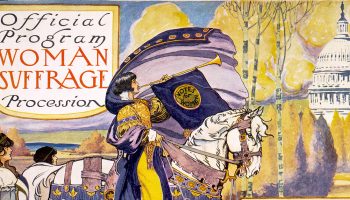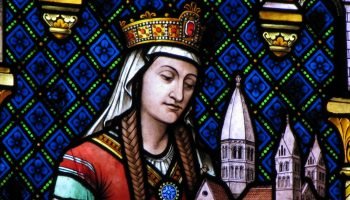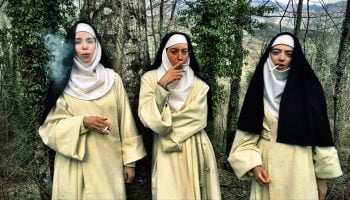This is Part 7 of The Public Medievalist’s special series: Gender, Sexism, and the Middle Ages, by Kathleen Crowther. You can find the rest of the series here.
The Christmas season is upon us in all its peppermint latte, Hallmark movie, ugly sweater glory. Despite hand-wringing by some conservative commentators over the “war on Christmas,” nativity scenes continue to hold their own alongside the more-secular signs of the season. Every one of these nativity scenes—from the 18th-century Neapolitan terra cotta crèche on display in the White House to this Fisher-Price Little People Nativity Playset—has a Virgin Mary gazing lovingly at her divine baby.
For some non-Muslims, it may come as a surprise that the Virgin Mary is revered by Muslims as well as by Christians. But the Virgin Mary (or Maryam, as she is known in Arabic) is one of the most venerated women in Islam, a status she has held since the founding of the religion in the seventh century.
She is ranked among the holiest women in Islam, a group that includes Khadija and A’isha, the wives of the Prophet, and Fatima, his daughter. Like them, she is held up to both women and men as an exemplar of piety and devotion to God.
In fact, Maryam is the only woman identified by name in the Qur’an, where she is described as “a symbol [of God’s grace] unto all people” (Sura 21: 91). She is the only woman to have a sura (or chapter) named after her—Sura 19.

In an earlier essay in this series, Vanessa Corcoran demonstrated that medieval European representations of the Virgin Mary challenge our stereotypes of medieval Christian women as silent and powerless. For European Christians, the Virgin Mary was a powerful and commanding figure. She took up arms to defend the faithful and punish the wicked, and she skillfully debated the Devil himself. She was far more than the serenely smiling icon of maternal devotion that we see all around us this season.
Exploring the place of the Virgin Mary in medieval Islamic culture can similarly challenge our stereotypes of Muslim women, both medieval and contemporary. It also challenges a nasty stereotype that paints Islam as an inherently misogynistic religion.
As we will see, respect for women is also “traditional” in Islam. This is seen not just of the Islamic story of Mary, but also in the stories of the thousands of Muslim women who became recognized religious students and scholars in the Middle Ages.
The Virgin Mary in the Qur’an
For Muslims, Mary is special from the moment of her conception. Her story begins with her mother Anna. One day Anna, barren and past the age of childbearing, sits under a tree and watches a mother bird with her chicks. As she does so, she is overcome by longing for a child. She and her husband Amran (or Imran) pray for one; God grants their wish. Anna becomes pregnant and vows that she will dedicate her child to God’s service in the temple. She names the baby girl Mary and, once the child is weaned, Anna makes good on her promise and delivers her to the temple.
After Mary reaches the age of puberty, God sends the Angel Gabriel to her in the form of a handsome young man. Gabriel tells Mary,
I am but a messenger of thy Sustainer, [who says] “I shall bestow upon thee the gift of a son endowed with purity.”
To which Mary responds,
How can I have a son when no man has ever touched me?—for, never have I been a loose woman!
The angel tells her that God can do anything, and that her child will be “a symbol unto mankind and an act of grace from Us.” (Sura 19:19-21) Although the Qur’an simply states, “We [i.e. God] breathed into her Our spirit,” scholars devoted considerable attention to how this conception occurred. Most thought Gabriel blew the spirit of God into Mary, but they differed on whether Gabriel blew into neckline, sleeve or hem of Mary’s garment, or into her mouth. The expression “spirit of God” recurs a number of times in the Qur’an and signifies the life that God breathes into every human being. This makes the conception of Jesus miraculous, but in contrast to the Christian version, it does not entail that He is the Son of God.
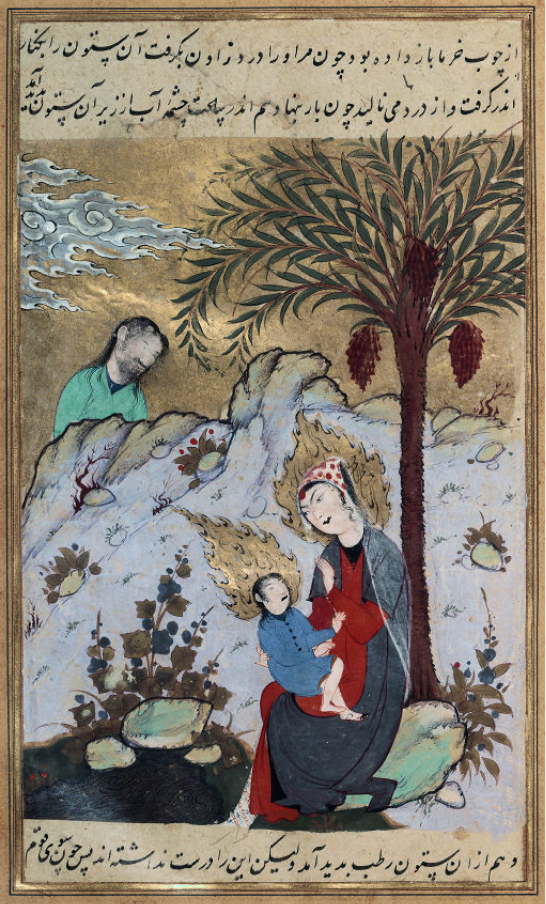
The birth of Jesus is also markedly different; the Islamic account has none of the accoutrements of a traditional Christian nativity scene. Instead, after she becomes pregnant Mary withdraws “to a far-off place,” to avoid the censure of her kin and community. (Sura 19:22) She goes into labor alone, at the foot of a palm tree, and cries out in anguish to God:
Oh, would that I had died ere this, and had become a thing forgotten, utterly forgotten” (Sura 19:23)
A voice from the palm tree tells her that God has sent her sustenance in the form of water under the place where she sits, and fresh dates in the palm tree (despite it not being the season for dates).
She gives birth to Jesus (Isa) and returns with him to her people. They are shocked and horrified to see her with a newborn, believing she is guilty of illicit sex. But Mary points to the baby Jesus, who announces:
Behold, I am a servant of God. He has vouchsafed unto me revelation and made me a prophet… Hence, peace was upon me on the day when I was born, and [will be upon me] on the day of my death, and on the day when I shall be raised to life [again]. (Sura 19:30,33)
If you are a Christian, or are familiar with Christianity, some details of the Islamic version of the life of the Virgin Mary might seem exotic. Take, for example, the miraculous appearance of out-of-season fruit in the locked mihrab and the birth of Jesus under a palm tree. But in its essential outlines, the story is very similar. Both Christians and Muslims believe that Mary was a virgin when she gave birth to Jesus, and both religious traditions hold her up as a model of piety and obedience to God’s will. However, these similarities can be misleading. Some aspects of the story of the Virgin Mary have very different meaning and significance for Muslims.
Mary: Like a Virgin
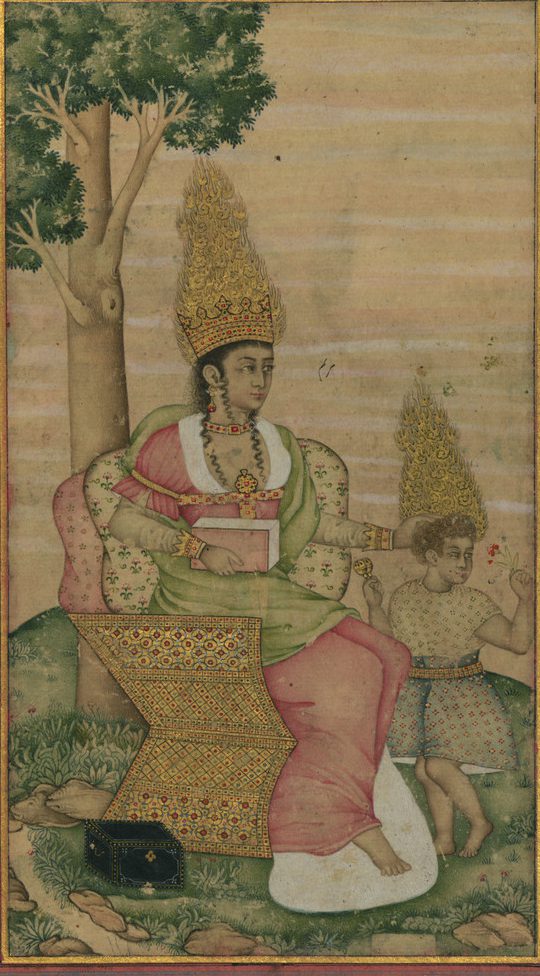
Muslims and Christians, at least dogmatically, agree that Mary was a virgin when she conceived and bore Jesus. Medieval Christians insisted on the “perpetual virginity” of Mary—that is, they believed that Mary remained a virgin her entire life, despite her marriage to Joseph. In fact, medieval Christian theologians went through various mental gymnastics to get around biblical references (Mark 6:3, and Matthew 13:55–56) to Jesus’ “brothers”: James, Joseph, Jude, and Simon.
This is because medieval Christians elevated virginity to a spiritually superior state. To many medieval Christian theologians, sex, even within the context of marriage, was considered to be always somewhat sinful. For example, the great Church Father Augustine linked sex to original sin (original sin, by the way, is not a concept found in Islam). Thus, it was critical to Christians that Mary remained virginally pure her entire life.
By contrast, for Muslims, whether Mary was a virgin or not after the birth of Jesus is irrelevant. Certainly, in both Christianity and Islam, virginity, especially in women, was equated with physical and spiritual purity. And, both Muslim and Christian women were expected to remain virgins until marriage. But for Muslims, lifelong celibacy is not better than marriage and childbearing, both for men and for women. Sex within the context of marriage is neither sinful nor a mark of impiety.
So if Mary married and had more children after the birth of Jesus (a question most Muslim commentators actually never even bothered with), in Islam, this would do nothing to diminish her status as a holy woman. Historian Marina Warner characterized the Virgin Mary as “alone of all her sex,” due to her paradoxical place in Christianity, where she is both a physically and spiritually pure virgin and also a mother. This made her unlike any other woman. By contrast, in Islam, Mary is viewed as on par with three married women, Khadija, A’isha, and Fatima, who conceived and bore children the natural way.
Medieval Islamic theologians agreed among each other that Mary’s son Jesus was a prophet. They disagreed, however, about whether or not Mary herself was a prophet. While most argued that she was not, two Andalusian theologians, Ibn Hazm (d. 1064) and Al-Qurtubi (d. 1272), insisted that she was. Al-Qurtubi asserted,
Truly Maryam is a prophetess because God inspired her through the angel in the same way He inspired the rest of the male prophets.
Ibn Hazm wanted to extend the status of prophet not only to Mary but to the mothers of Isaac and Moses as well. Both sides of this debate used passages from the Qur’an to justify their positions. (Mary is listed among the prophets described in the Qur’an in Sura 21). Artists’ representations of Mary and Jesus reflect this controversy. Almost all Islamic artists depicted Jesus with a crown of flames, the symbol of a prophet. But some chose to depict Mary with a crown of flames as well.
Thinking Women in Medieval Islam
Debates about whether or not Mary was a prophet are particularly interesting because in the medieval Islamic world, unlike the medieval Christian world, large numbers of women were respected as religious scholars and teachers. In Islam, the most important sources of religious knowledge, other than the Qur’an, are the collections of hadith. Hadith are considered to be the words of the Prophet Muhammad as conveyed orally to his companions and those around him during his lifetime. Hadith were often issued in response to specific questions posed to the Prophet, and they constitute teachings and decisions on a huge range of topics, which form the basis of Islamic law and religious practices. While the different branches of Islam differ over the importance and validity of individual hadith, in general they are incredibly important.
Many of the early hadith transmitters were women, including the wives of the Prophet. But by the 9th century, the study and teaching of hadith had been restricted largely to men.
But then a shift occurred: between the 10th and the 15th century, according to historian Asma Sayeed, women returned to prominence as religious scholars and teachers. They did this by arguing that the exclusion of women was not traditional. In other words, medieval Muslim women scholars and their allies asserted that barring women from sacred spaces and from positions of authority was not consistent with the Qur’an, the teachings of the Prophet, or the earliest practices of the Islamic community. Instead, they argued, the exclusion of women was a later development that deviated from the true spirit of Islam.
Recent scholarship has demonstrated that there were thousands of women studying and teaching the Qur’an and hadith in the Middle Ages. These women include Umm al-Darda, a 7th-century teacher of hadith and fiqh (Islamic law) whose students included the Caliph of Damascus; Karima al-Marwaziyya, an 11th-century scholar from Mecca who was one of the foremost authorities on a collection of hadith known as the Ṣaḥīḥ al-Bukhārī; and Fatimah al-Bataihiyyah, a 14th-century Syrian scholar who taught hadith at the mosque of the Prophet in Medina. The numbers of women studying and teaching the Qur’an and hadith in the Middle Ages defy all modern stereotypes of the role of women in Islam.
There were and are Muslim groups who use the Qur’an and hadith to justify oppressions such as barring women from educational and professional opportunities, enforcing rigid dress codes, child marriage, and female genital mutilation. Although such practices make headlines and draw international condemnation (as they should), it is a mistake to believe that the misogyny of such groups represents the full spectrum of ideas about women and gender in the Islamic tradition.
Today Muslim feminists make arguments for the inclusion of women into religious and public domains that are very similar to the ones their medieval predecessors made. These feminists face opposition not just from Islamic fundamentalists, but also from Western secular feminists who frequently see Islam as an inherently oppressive, patriarchal religion from which women must be liberated.
Looking at the place of the Virgin Mary in Islamic culture foregrounds the more egalitarian aspects of Islamic history and teaching. It is important to remember that these are every bit as traditional and authentically Islamic as beliefs about female inferiority.
For further reading
Aliah Schleifer, Mary the Blessed Virgin of Islam (Louisville, KY: Fons Vitae, 1997).
Jane I. Smith and Yvonne Y. Haddad, “The Virgin Mary in Islamic Tradition” The Muslim World vol. LXXIX nos. 3-4 (July/October 1989): 161-187.
Note: The translation of the Qur’an which I used is the Message of the Qur’an. The Full Account of the Revealed Arabic Text Accompanied by Parallel Transliteration, translated and explained by Muhammad Asad (Bristol, England: The Book Foundation, 2003).
If you enjoyed that article, please share it with your history-loving friends on Facebook, or on Twitter! And be sure to subscribe here to receive every new article from The Public Medievalist the moment it launches.
